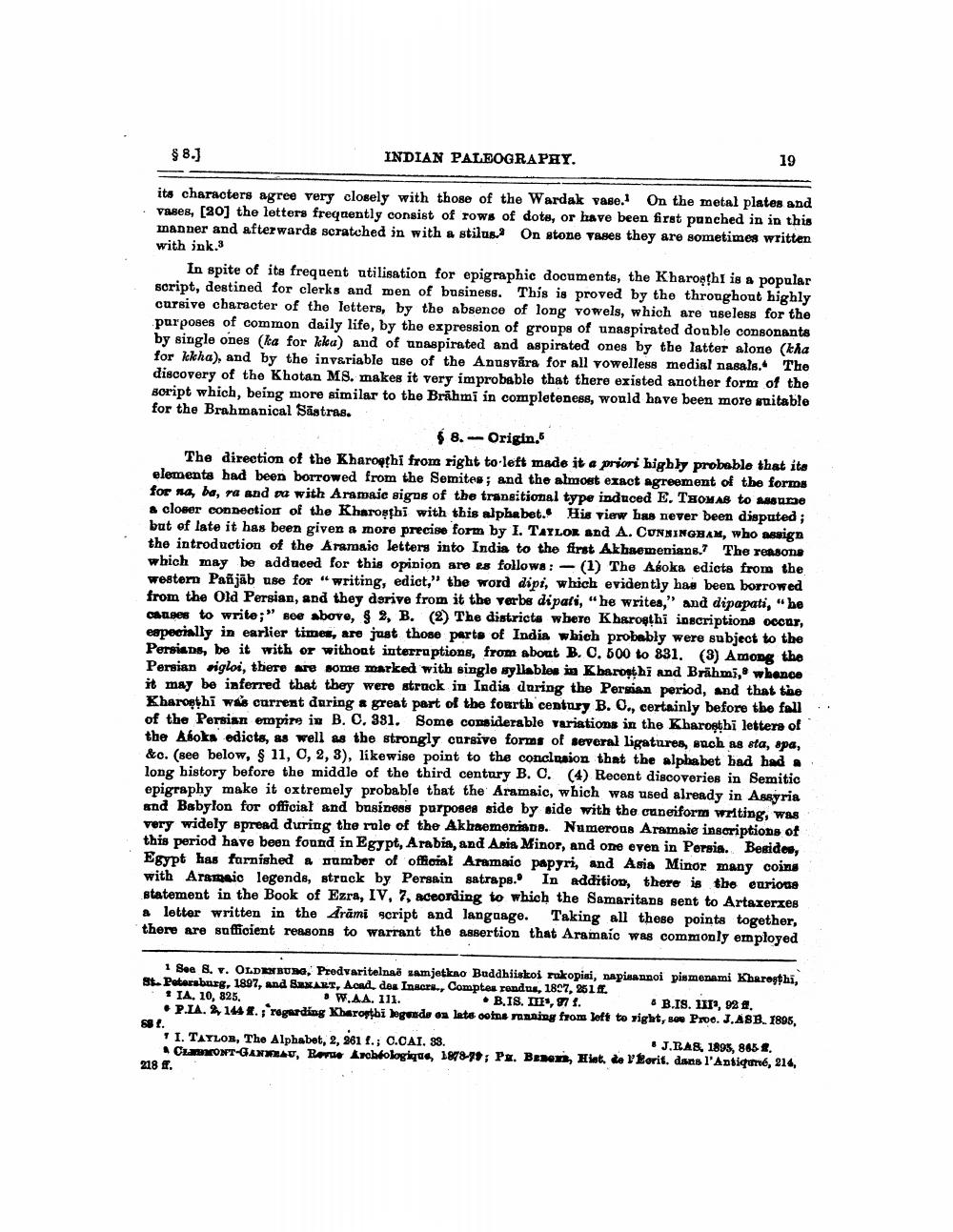________________
$8.)
INDIAN PALEOGRAPHY.
19
its characters agree very closely with those of the Wardak vase. On the metal plates and Vases, [20] the letters frequently consist of rows of dots, or have been first punched in in this manner and afterwards scratched in with a stilus. On stone vases they are sometimes written with ink.
In spite of its frequent utilisation for epigraphic documents, the Kharoşthi is a popular script, destined for clerks and men of business. This is proved by the throughout highly cursive character of the letters, by the absence of long vowels, which are useless for the purposes of common daily life, by the expression of groups of unaspirated donble consonants by single ones (ka for kka) and of unaspirated and aspirated ones by the latter alone (kha for Ickha), and by the invariable use of the Anusvāra for all vowelless modial nasals. The discovery of the Khotan MS. makes it very improbable that there existed another form of the soript which, being more similar to the Brahmi in completeness, would have been more suitable for the Brahmanical Sastras.
$ 8.-Origin,5 The direction of the Kharoqțhi from right to left made it a priori highly probable that its elementa had been borrowed from the Semites; and the almost exact agreement of the forms for na, ba, ra and a with Aramaie sigos of the transitional type induced E. THOMAS to assume & closer connection of the Kharoşthi with this alphabet. His view has never been disputed; but of late it has been given a more precise form by I. TAYLOR and A. CUNNINGHAM, who assiga the introduction of the Aramaic letters into India to the first Akbaemenians. The reasone which may be adduced for this opinion are as follows:- (1) The Aboka edicts from the Western Pañjāb use for " writing, edict," the word dipi, which evidently has been borrowed from the Old Persian, and they derive from it the verbs dipali, "he writes," and dipapati, "be causes to writo;" soe sbove, $ %, B. (2) The districts where Kharoethi inscriptions occur, especially in earlier times, are just those parts of India which probably were subject to the Persians, be it with or without interruptions, from about B. O, 500 to 831. (3) Among the Persian rigloi, there are some marked with single syllables in Kbarorthi And Brähmi, whance it may be inferred that they were struck in India during the Persian period, and that the Kharosthi wis current during a great part of the fourth century B. O., certainly before the fall of the Persian empire in B. C. 391. Some considerable variations in the Kharonthi letters of the Aboka edicts, as well as the strongly cursive forms of several ligatures, such as sta, spa, &c. (see below, $ 11, 0, 2, 3), likewise point to the conclusion that the alphabet bad had. long bistory before the middle of the third century B. O. (4) Recent discoveries in Semitic epigraphy make it oxtremely probable that the Aramaic, which was used already in Assyria and Babylon for official and business purposes side by side with the cuneiform writing, was very widely spread during the rule of the Akhaemenians. Numerous Aramaie inscriptions of this period have been found in Egypt, Arabia, and Asis Minor, and one even in Persis. Besides, Egypt has tarnished a number of official Aramaic papyri, and Asia Minor many coins with Aramaic legende, struck by Persain satraps. In addition, there is the euriods statement in the Book of Ezra, IV, 7, aceording to which the Samaritans sent to Artaxerxes a letter written in the Arāmi script and language. Taking all these points together, there are sufficient reasons to warrant the assertion that Aramaic was commonly employed
1 See 8. F. OLDENBURG, Predvaritelnaē zamjetkao Buddhiiskoi rukopisi, napisannoi pismenami Khrrogthi, St. Petersburg, 1807, and SMART, Acad. des Inscru., Comptes rendus, 1807, 26114. IA. 10, 825.
W.AA. 111. • B.IS. III, 97 .
B.IS. 111, 92 • PLA. 144 . regarding Kharopfbi bogende os late ootne ranning from left to right, so Proc. J.ASB. 1895, St. 1. TAYLOR, The Alphabet, 2, 261 f.; C.CAI. 33.
• J.LAB, 1895, 865 . C O NT-GAMMAU, Revue robiologique, 1878-77; Ps. Benen, Hiat. de v korit, dans l'Antimé, 214, 218 ff.




